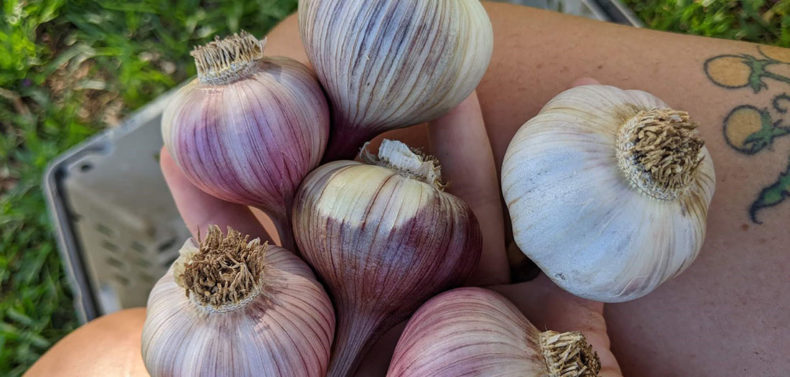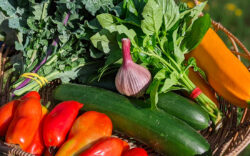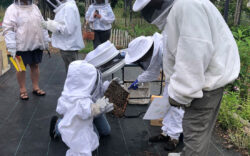For the effort and taste, you’ll find garlic a worthwhile plant in winter. Plant garlic bulbs in Northeast Georgia from September through the beginning of December. Garlic grows best in loose soil, with plenty of compost and mulch on top to protect against hard winter freezes.
“Plant the garlic when the kids go to school and harvest when they get out,” is the rule of thumb I heard in North Carolina, and it seems to be true in Georgia as well. Northeast Georgia gardeners can stretch the garlic planting season until December because in recent years, freezes have come later in the fall. Cold fronts lower the temperature of the soil much more slowly than the temperature of the air. As I write this, the air outside is 24 degrees, but the soil temperature, according to the State Botanical Garden’s weather sensor, is 52 degrees. Garlic germinates best in the range of 40–50 degrees.
Homegrown garlic, like tomatoes and cucumbers, taste better than what you can buy in the grocery store. It’s also a bulb that springs up surprisingly green and tender in the coldest part of the year. Garlic makes a garden look less empty and forlorn. Garlic isn’t a picky plant: You won’t need frost cloth or special irrigation. The plants will require a layer of mulch for hard late-winter freezes, but that’s about it.
There are a dizzying array of garlic varieties to choose from, usually broken down into softneck and hardneck types. More experienced Athens-area farmers swear by softneck garlic as the best for Northeast Georgia. Inchelium Red is a popular variety. Last year—my first growing garlic in my own garden—I could not find a softneck garlic in stock on four different websites. I ended up buying the hardneck Pehoski Purple, a lovely stripy purple garlic bred especially to handle frigid winters. The garlic didn’t grow super large, but they did grow, and they tasted great. Don’t let indecision stop you from trying a variety you could love. I bought a softneck variety this year, along with last year’s Pehoski Purple, and I’m excited to see (and taste!) the differences during harvest.
Hardneck garlics produce scapes, a winding stem that will, eventually, lead to a blooming flower. For the best hardneck garlic harvest, you’ll want to snip the scapes. Otherwise, the plant will move its energy into producing a flower, and then seeds, instead of storing more energy in the bulb. Garlic scapes are edible and taste like fresh, green garlic. You can sub scapes in for garlic in recipes like pesto, or fry them in oil and add them as a topping to dishes needing an extra pop. Softneck varieties do not produce scapes.
Once you choose your garlic, you’ll need to separate the cloves right before you plant it. Keep as much skin on the cloves as possible. The papery skin is a protective layer that helps the bulb stay fleshy and not dry out. You’ll want a fairly fluffy soil mixed with some compost. If you don’t use a tiller, you can use a shovel to cut into the dirt a few times and break up any clod bigger than a fist. Dig a hole 2–3 inches deep. Place one clove per hole, with the pointy end up and the nubbin bottom (where it was connected to the rest of the bulb) pushed lightly into the soil. Bigger cloves grow into bigger bulbs in the spring, so I usually discard the smallest clove bits. I planted my garlic cloves 8 inches apart this year. Last year, I used 6-inch spacing, and it was a little tight for easy spring weeding and early summer harvesting.
You’ll want to mulch before January. Try to find a mulch a little lighter than bark or wood chips. Pine needles, torn leaves or straw are easy-to-access options. Whatever mulch you use will get mixed into the soil after your garlic harvest, and chunks of wood take longer to break down than other mulches. The wood can bind nitrogen, depriving future plants headed into the same area of a needed nutrient. I used wood chips for my garlic rows last year and noticed a loss of fertility, despite adding compost.
Irrigation becomes important with garlic in the spring, when the bulbs start sizing up. Too much rain, and the garlic could rot before you have a chance to pull it up. Too little rain, and you’ll have undersized bulbs. Depending on variety, weather and when you planted, your garlic will be ready to harvest in May or June. Harvest hardneck varieties a few weeks after you cut the scapes. When a majority of the garlic leaves start drooping and turning brown, that’s the time to grab your shovel and start digging up those bulbs.
You’ll want to cure your garlic harvest—leaving it to dry in a sheltered spot for two or more weeks before cooking with it. Some folks braid the garlic leaves together, but I worry too much about mold and mildew infiltrating my carefully cured produce. I cut the leaves off and leave the garlic with a little stem on top before storing.
Growing garlic takes work, but not much. For a backyard garden, there aren’t many other plants that require as little room and pack as big a flavorful punch as garlic.
Like what you just read? Support Flagpole by making a donation today. Every dollar you give helps fund our ongoing mission to provide Athens with quality, independent journalism.










